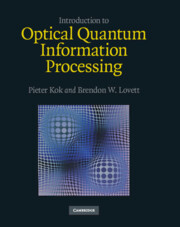Book contents
- Frontmatter
- Dedication
- Contents
- Preface
- Part I Quantum optics and quantum information
- Part II Quantum information in photons and atoms
- 4 Photon sources and detectors
- 5 Quantum communication with single photons
- 6 Quantum computation with single photons
- 7 Atomic quantum information carriers
- Part III Quantum information in many-body systems
- Appendix A Baker–Campbell–Haussdorff relations
- Appendix B The Knill–Laflamme–Milburn protocol
- Appendix C Cross–Kerr nonlinearities for single photons
- References
- Index
6 - Quantum computation with single photons
from Part II - Quantum information in photons and atoms
Published online by Cambridge University Press: 05 July 2014
- Frontmatter
- Dedication
- Contents
- Preface
- Part I Quantum optics and quantum information
- Part II Quantum information in photons and atoms
- 4 Photon sources and detectors
- 5 Quantum communication with single photons
- 6 Quantum computation with single photons
- 7 Atomic quantum information carriers
- Part III Quantum information in many-body systems
- Appendix A Baker–Campbell–Haussdorff relations
- Appendix B The Knill–Laflamme–Milburn protocol
- Appendix C Cross–Kerr nonlinearities for single photons
- References
- Index
Summary
In the previous chapter we developed some of the basic aspects of quantum information processing with single photons as qubits. Apart from noting the obvious benefit of using light for quantum communication, we identified some difficulties in manipulating quantum information that is encoded in photons. In particular, it is difficult to construct two-qubit gates for photonic qubits. In this chapter we will have to face this difficulty head-on in our discussion of quantum computation with single photons and linear-optical elements. The possibility of a quantum computer based on single photons, linear optics, and photon counting was demonstrated in a landmark paper by Knill, Laflamme, and Milburn in 2001. Their protocol is commonly referred to as the ‘klm protocol’. In subsequent years, the klm protocol has been dramatically slimmed down in terms of complexity and the necessary resources to create the universal set of quantum gates. For pedagogical reasons we give the streamlined version here, and we briefly describe the original klm protocol in Appendix 2. We will make extensive use of the results in Section 1.4 about mode transformations, and Section 2.3 about cluster-state quantum computing. We start this chapter, however, with a description of linear-optical networks, and how they fail as deterministic quantum computers. In Section 6.2 we discuss the principle of post-selection, and how this can be used to create probabilistic gates with deterministic feed-forward control.
- Type
- Chapter
- Information
- Introduction to Optical Quantum Information Processing , pp. 179 - 209Publisher: Cambridge University PressPrint publication year: 2010
- 1
- Cited by



